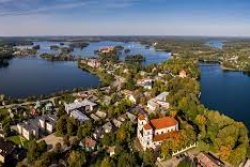Author: Rodžers Kleists
Source: Rodžers Kleists
Latvia hasn’t been particularly lucky when it comes to sea islands – unlike our northern neighbors, the Estonians, who are so generously endowed with islands that they’ve even jokingly offered to sell one to their southern Baltic nation. And yet, this one island – Ruhnu, or Roņu sala in Latvian – is truly special. So special, in fact, that during the time of the Duchy of Courland, it was an integral part of Duke Jacob’s estate and even served as his place of exile. Today, in the island’s wooden church, you can find a portrait of Duke Jacob Kettler – a poignant reminder that yesterday’s triumph can quickly become tomorrow’s downfall.
Ruhnu Island is also rich in legends. One of them tells how, by the end of World War II, the island’s Swedish inhabitants chose – by referendum – to join Estonia. Possibly, this decision was swayed by the generosity of the Estonians, who brought barrels of herring and sugar to the island. This episode has become part of the island’s anecdotal history and speaks volumes about the simple yet effective diplomacy of the Baltic region.
Reklāma
Though small in size, the island holds great allure. Just 12 nautical miles from Cape Kolka, its proximity to the Latvian coast and unique topography make it a favorite among sea travelers, yacht crews, and adventure seekers. Every summer, dozens of cutters, sailboats, and motor yachts flying the Latvian flag dock at this remote yet welcoming place. This year, something truly exclusive has joined this circle of visitors – private flights from Spilve Aerodrome, offering a full sightseeing program to Ruhnu from the air.
Island Community – A Model of Northern Hospitality
In the winter, only about 50 residents call the island home, but this small community is a shining example of hospitality, friendliness, and islander resilience. Ruhnu has its own ambulance, school, a couple of shops, a tavern, and a hotel – but not a single police officer. In summer, the number of inhabitants doubles as holidaymakers, nature lovers, and those seeking peace settle in. Despite its physical closeness to Latvia, Ruhnu Island has remained for decades outside our collective consciousness – a hidden pearl, tucked away beyond the Irbe Strait.
The First Airborne Assault in Military History
But Ruhnu hasn’t always been a haven of peace. It is also a silent witness to one of the most significant moments in military innovation history. On June 15, 1917, the German Imperial Naval Air Forces carried out an operation that is now considered the first airborne assault in the history of warfare.
The historically important operation, known as “The Raid on Ruhnu”, took place during World War I. German seaplanes not only bombed the Russian Empire’s telegraph station on Ruhnu Island but also landed on the island and continued the attack on foot, destroying the remaining facilities with explosives. The raid met no resistance, and all aircraft successfully returned to base. This is the first recorded instance in which aviators conducted an air attack and then acted as a ground unit.
This tactical innovation gave the Germans a strategic advantage in the Gulf of Riga and served as a precursor to larger offensives – including the Riga Offensive on September 1, and Operation Albion, during which the Germans captured Saaremaa and Ruhnu.
An Island as a Living Book of History and Nature
Today, Ruhnu Island is still a place where nature has not lost its voice. Ornithologists come here to observe rare bird species; travelers walk the peaceful forests and beaches; history lovers explore the intersection of sea, sky, and war.
With the tourism season just around the corner, many travel offers will soon be available. But we warmly encourage you to step into the leather jackets of daring German naval aviators and enjoy a private flight from https://exclusivejourney.eu/en/flyghtsen. Ruhnu is not just a destination – it’s an adventure, a story, and a discovery waiting for its traveler. Here, time moves slower, the stars shine closer, and history whispers through the sea breeze.
To publish this article please contact BalticTravelnews.eu editorial board







